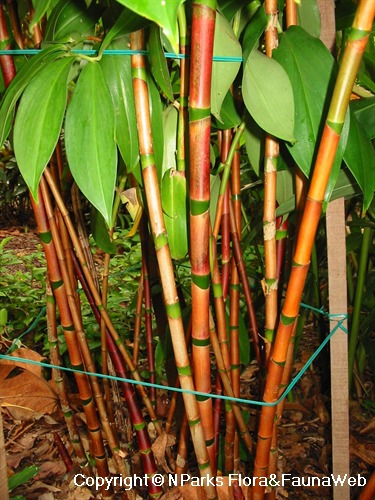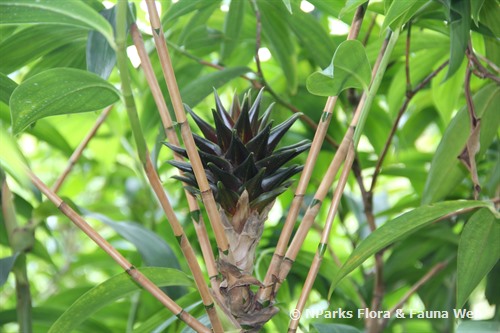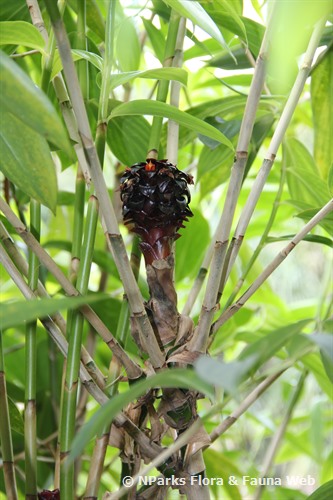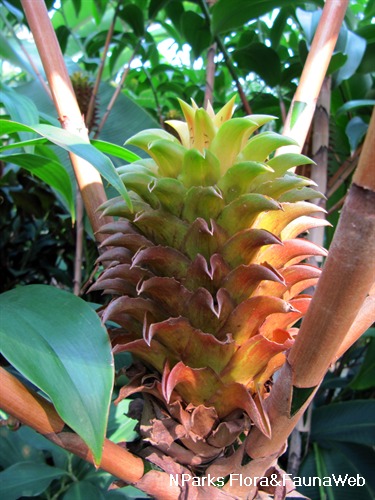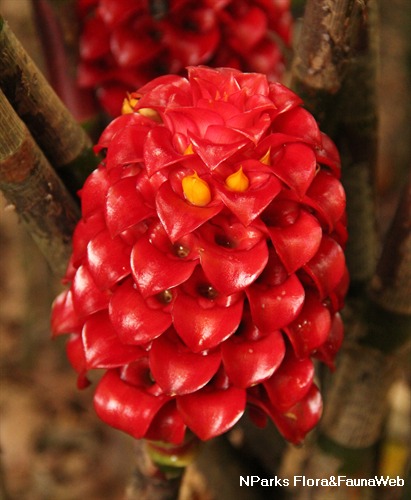
Back
Tapeinochilos ananassae
| Family Name: | Costaceae |
| Common Name: | Pineapple Ginger, Giant Spiral Ginger, Indonesian Wax Ginger |
Name
Classifications and Characteristics
| Plant Division | Angiosperms (Flowering Seed Plants) (Monocotyledon) |
|---|---|
| Plant Growth Form | Shrub |
Biogeography
| Native Distribution | Eastern Indonesia & Northern America |
|---|---|
| Native Habitat | Terrestrial |
| Preferred Climate Zone | Tropical |
| Local Conservation Status | Non-native (Horticultural / Cultivated Only) |
Description and Ethnobotany
| Growth Form | It is a herbaceous plant with underground rhizomes and grows to about 2 - 4 m tall. |
|---|---|
| Foliage | Leaves are dark green, arranged spirally around the stems, measuring about 35 cm long and 15 cm wide. |
| Stems | Herbaceous, bamboo-like stems and has underground rhizome. |
| Flowers | Has the appearance of and upside down pineapple; dark red and has cone-shaped bracts enclosing the yellow flowers. |
| Fruit | Cone-like, red bracts which will slowly turn to brown. |
| Etymology | The genus Tapeinochilos means modest-lip, which refers to the small labellum of inflorescence. The specific epithet |
Landscaping Features
| Desirable Plant Features | Ornamental Flowers, Ornamental Foliage |
|---|---|
| Landscape Uses | Small Gardens |
Plant Care and Propagation
| Light Preference | Semi-Shade |
|---|---|
| Water Preference | Lots of Water |
| Rootzone Tolerance | Moist Soils, Well-Drained Soils |
Foliar
| Foliage Retention | Evergreen |
|---|---|
| Mature Foliage Colour(s) | Green |
| Foliar Type | Simple / Unifoliate |
| Foliar Attachment to Stem | Petiolate |
| Foliar Shape(s) | Non-Palm Foliage (Elliptical) |
| Foliar Venation | Parallel |
| Foliar Margin | Entire |
| Foliar Apex - Tip | Acuminate |
| Leaf Area Index (LAI) for Green Plot Ratio | 3.5 (Shrub & Groundcover - Monocot) |
Floral (Angiosperm)
| Flower Colour(s) | Red |
|---|---|
| Flower Grouping | Cluster / Inflorescence |
Image Repository
Others
| Master ID | 1204 |
|---|---|
| Species ID | 2497 |
| Flora Disclaimer | The information in this website has been compiled from reliable sources, such as reference works on medicinal plants. It is not a substitute for medical advice or treatment and NParks does not purport to provide any medical advice. Readers should always consult his/her physician before using or consuming a plant for medicinal purposes. |

